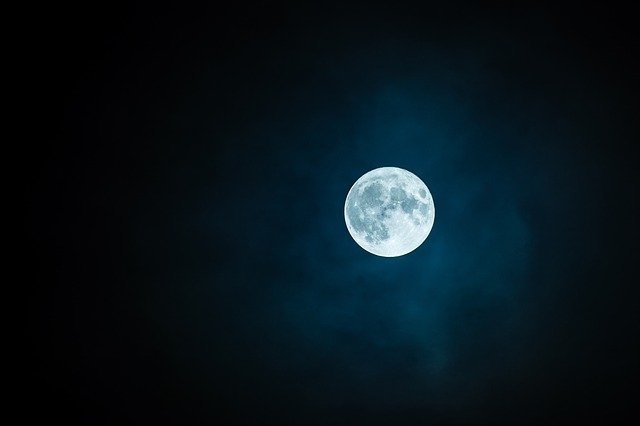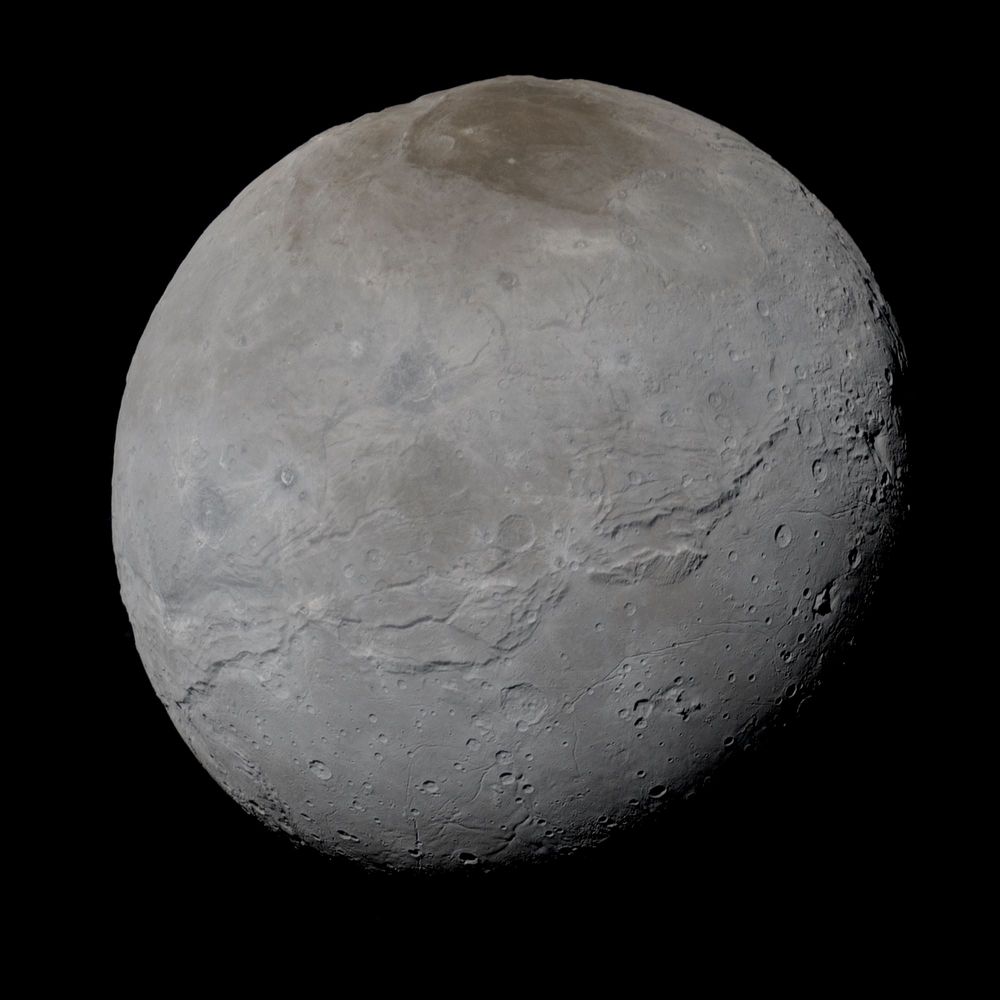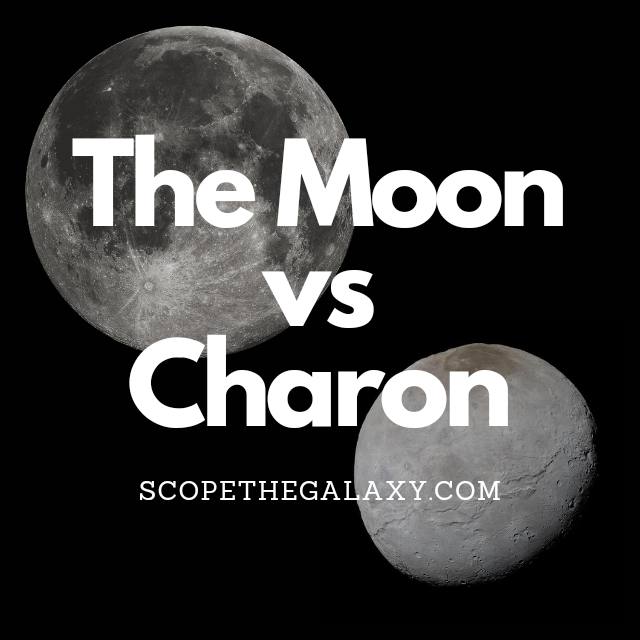*This post may contain affiliate links. This means we may make a commission if you purchase an item using one of our links*
The main differences between the Moon and Charon is that the Moon is far bigger with a diameter of 3474.8km whilst Charon’s diameter is 1,212km, the Moon is the only natural that orbits Earth whilst Charon is one of 5 moons that orbit Pluto, the Moon is nearly twice as dense as Charon and is also joint 3rd in closeness to the Sun whilst Charon is joint 9th.
There are other differences between these two natural satellites too, so continue reading for a more detailed look at each entity below along with their similarities and differences.
What Is The Moon?
Table of Contents

The moon is the gray celestial being that orbits our Earth. It is also tidally locked to Earth meaning that we only see one side of it at any time in our sky.
It takes the moon roughly 27 days to complete an orbit around Earth, which it does in an elliptical pattern. The Moon’s axial tilt is very straight at 1.5 degrees. As a result of the tidally locked status along with the effects that Earth has on its general rotational patterns, it takes the Moon roughly 29.5 days to complete a day.
In regards to its temperature, it fluctuates where it can be really hot at 127 degrees Celsius when the Sun is shining on it and to -173 degrees in areas where the Sun does not strike it. It’s core on the other hand is far hotter ranging between 1,327 to 1,427 degrees Celsius.
This is as a result of the lunar entity’s extremely thin to practically non-existent atmosphere, which not only results in these massive temperature shifts but, is also the reason why it has over 100,000 craters on its surface.
Speaking of the Moon’s surface, the entity is mostly made of rocks, iron, magnesium just like most of the other moons and terrestrial based planets in our solar system.
It is among the bigger moons in our solar system with a diameter of 3,474.8km and a mass of 7.35 × 10^22 kg, which actually places it fifth amongst all moons in our solar system and would also make it bigger than the dwarf planet Pluto.
Despite all the advancements in technology, the last time a manned mission was made to the Moon was on the Apollo 17 way back in December 1972 and no further missions have been done since, possibly as result of the political agendas behind the numerous countries vying for opportunities that we don’t know of.
What Is The Moon Charon?

Charon is the largest of Pluto’s moons, first discovered on 22nd June 1978. The surface of this icy world is frozen with nitrogen and methane ice; it may also hold some water ice. While Pluto possesses a reddish hue, Charon is closer to a neutral shade of grey; this suggests the two bodies have different compositions.
Scientists named this moon after the mythical ferryman, Charon, who once carried souls across the Acheron river. This river is one of five legendary rivers that could lie beneath the surface of Pluto.
The formation of Charon remains something of a mystery to scientists. However, this moon may have formed around 4.5 billion years ago when an object traveling at immense speed collided with Pluto. Its average distance from the Sun is approximately 3.6 billion km.
Charon is almost half the size of its planet at 1,212km, where scientists refer to these two bodies as a “double dwarf planet system,” and the chilly temperatures vary from minus 23 to minus 258 degrees Celsius.
Charon takes 153 hours to orbit its planet at an average distance of 19,640km, and it is tidally locked, meaning the same side of the moon always faces Pluto. Pluto also experiences a tidal lock to Charon, so the same two sides always face one another.
Among the fascinating features of this ice moon are the ice volcanoes that could exist on the surface. Observations from the Gemini observatory suggest that Charon could have a form of cryovolcanism known as ice-particle geysers.
The frigid world also has a canyon between seven and nine kilometers deep. (To put that into perspective, Mount Everest has a height of 8.8km).
How Are The Moon And Charon Similar?
As both are natural satellites, the Moon and Charon do share a few similarities, which in this case includes the following:
- Both have a hotter central core.
- Both have a rocky, terrestrial surface.
- Both are spherical in shape.
- Neither have rings surrounding them.
- Both are tidally locked to their planet.
- Both orbit their planet in an elliptical pattern.
- Neither have tectonic plates.
- Both have a practically non-existent atmosphere.
- Neither have a magnetosphere.
Differences Between The Moon And Charon
As for the differences between the two, they include the following:
- The Moon is the bigger of the two with a diameter of 3474.8km compared to Charon’s diameter of 1,212km.
- A day on Charon takes 153 hours whilst the Moon completes a day in 29.5 days
- The Moon orbits the Sun in 365 days and Earth in 28 days whilst Charon orbits the Sun in 247.78 years and around Pluto in 153 hours.
- Charon’s density is 1.71 g/cm³ whilst the Moon’s density is 3.34 g/cm³.
- In regards to gravity, the Moon’s is 1.62 m/s² whilst Charon’s gravity is 0.288 m/s².
- In regards to their axial tilt, the Moon’s is 5 degrees whilst Charon’s is practically 0 degrees.
- The Moon’s temperature fluctuates between 127 degrees Celsius to -173 degrees Celsius whilst Charon’s temperature is -23 to -253 degrees Celsius.
- As for mass, Charon’s is 1.58 × 10^21 kg whilst the Moon’s mass is 7.35 × 10^22 kg.
- Charon’s average distance from Pluto is 19,640km whilst the Moon’s average distance from Earth is 384,400km.
Summary
The Moon and Charon are very similar in a variety of ways, especially taking into account both orbit other planets, have terrestrial physical compositions, are tidally locked to their respective planets and more.
But, there are also a variety of distinct differences between the two as well, whether it be in regards to mass, size, their temperatures, density and more.

